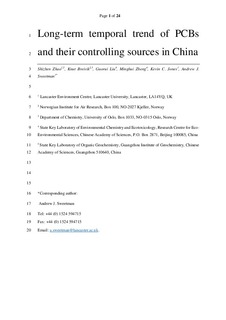| dc.contributor.author | Zhao, Shizhen | |
| dc.contributor.author | Breivik, Knut | |
| dc.contributor.author | Liu, Guorui | |
| dc.contributor.author | Zheng, Minghui | |
| dc.contributor.author | Jones, Kevin C | |
| dc.contributor.author | Sweetman, Andrew J | |
| dc.date.accessioned | 2017-12-04T11:03:47Z | |
| dc.date.available | 2017-12-04T11:03:47Z | |
| dc.date.created | 2017-01-28T12:01:45Z | |
| dc.date.issued | 2017 | |
| dc.identifier.citation | Zhao, S., Breivik, K., Liu, G., Zheng, M., Jones, K.C., & Sweetman, A.J. (2017). Long-term temporal trends of polychlorinated biphenyls and their controlling sources in China. Environmental Science & Technology, 51, 2838-2845. doi:10.1021/acs.est.6b05341 | nb_NO |
| dc.identifier.issn | 0013-936X | |
| dc.identifier.uri | http://hdl.handle.net/11250/2468978 | |
| dc.description.abstract | Polychlorinated biphenyls (PCBs) are industrial organic contaminants identified as persistent, bioaccumulative, toxic (PBT) and subject to long-range transport (LRT) with global scale significance. This study focuses on a reconstruction and prediction for China of long-term emission trends of intentionally and unintentionally produced (UP) Σ7PCBs (UP-PCBs, from the manufacture of steel, cement and sinter iron) and their re-emissions from secondary sources (e.g., soils and vegetation), using a dynamic fate model (BETR-Global). Contemporary emission estimates combined with predictions from the multimedia fate model suggest that primary sources still dominate, although unintentional sources are predicted to become a main contributor from 2035 for PCB-28. Imported e-waste is predicted to play an increasing role until 2020-2030 on a national scale due to the decline of IP emissions. Hypothetical emission scenarios suggest that China could become a potential source to neighbouring regions with a net output of ~0.4 t year-1 in the case of 7 PCBs around 2050. However, future emission scenarios and hence model results will be dictated by the efficiency of control measures. | nb_NO |
| dc.language.iso | eng | nb_NO |
| dc.title | Long-Term Temporal Trends of Polychlorinated Biphenyls and Their Controlling Sources in China | nb_NO |
| dc.type | Journal article | nb_NO |
| dc.type | Peer reviewed | nb_NO |
| dc.description.version | acceptedVersion | nb_NO |
| dc.rights.holder | Copyright © 2017 American Chemical Society | nb_NO |
| dc.source.pagenumber | 2838-2845 | nb_NO |
| dc.source.volume | 51 | nb_NO |
| dc.source.journal | Environmental Science and Technology | nb_NO |
| dc.source.issue | 5 | nb_NO |
| dc.identifier.doi | 10.1021/acs.est.6b05341 | |
| dc.identifier.cristin | 1439865 | |
| dc.relation.project | Norges forskningsråd: 213577 | nb_NO |
| cristin.unitcode | 7460,57,0,0 | |
| cristin.unitname | Atmosfære og klima | |
| cristin.ispublished | true | |
| cristin.fulltext | postprint | |
| cristin.qualitycode | 2 | |
